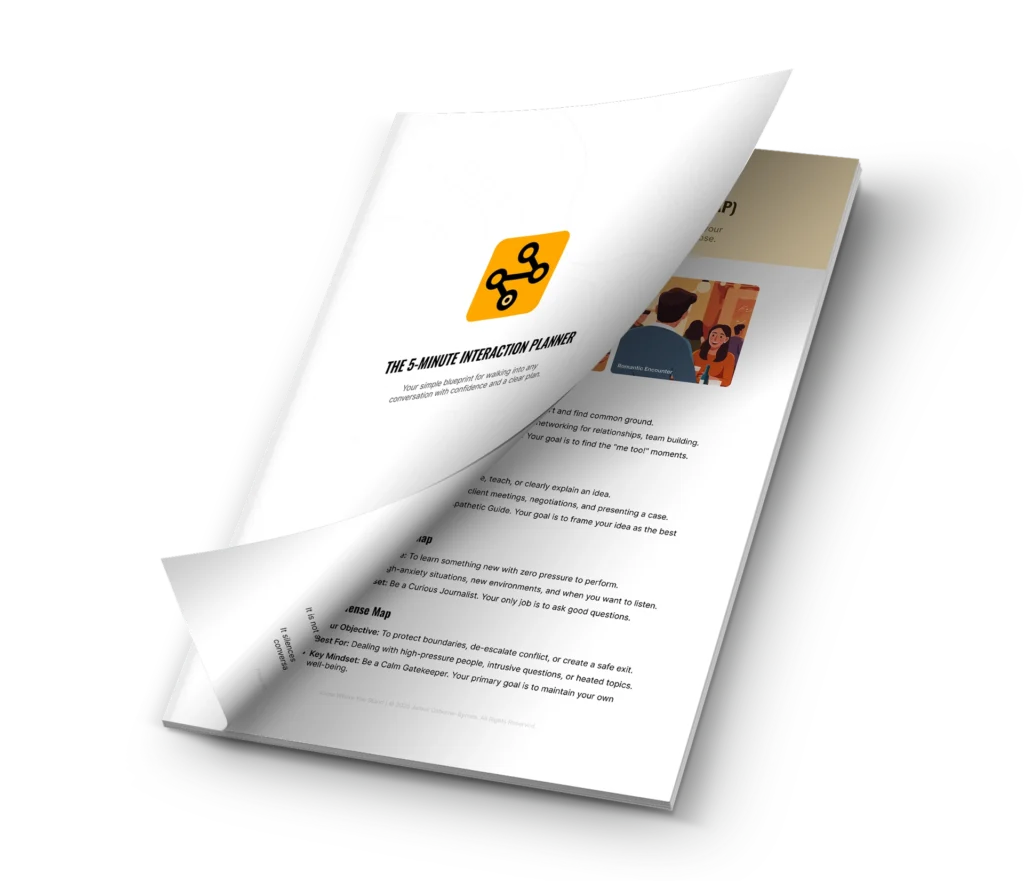You know the person. At a party or a meeting, they glide through conversations, seemingly aware of the room’s invisible currents. They know when to speak, when to listen, and who to approach. It feels like they can read minds. Meanwhile, the rest of us are stuck in our own heads, over-analyzing every crossed arm and stray glance, feeling a step behind. Here’s the truth: that person isn’t a mind reader. They aren’t gifted with some mystical social intuition you were born without. They are simply running a better observational program. The secret to learning how to read a room isn’t about memorizing a dictionary of gestures; it’s about focusing on the skill of establishing a baseline, which gives every other signal its meaning.
The Mistake in Reading Body Language
Most of our social anxiety comes from making one critical mistake when trying to read body language: we misinterpret isolated signals. We see a single piece of data and rush to a conclusion, often assuming the worst. This flawed approach causes us to react to noise instead of a true signal.
Someone crosses their arms, and our brain screams, “They’re closed off and angry at me!” A person looks away for a second, and we think, “I’m boring them.” This method of reading people’s intentions is a direct path to constant self-doubt and misinterpretation.
The Solution is to Put Signals in Context First
A skilled observer never analyzes a gesture in a vacuum. Their first job is to understand what is normal for a person in that specific situation. This provides the context needed for accurate social observation. This process involves tracking two key things.
Cruise Control
First is Cruise Control, which refers to a person’s baseline… their normal, at-rest state in a given environment. It includes their typical posture, speaking cadence, resting facial expression, and level of fidgeting.
Signal Spike
Second is the Signal Spike, a sudden and noticeable deviation from their Cruise Control. This deviation is the meaningful data point that actually deserves your attention.
How to Read a Room Using The Heart Rate Monitor Technique
To make this all click, think of the relationship between a baseline and a signal like a heart rate monitor.
First, you find their resting heart rate.
Imagine a person’s resting heart rate is 60 beats per minute. That number, 60, is their baseline. It’s their Cruise Control. By itself, it tells you they are in a state of calm. You wouldn’t see that number and assume something was wrong. It’s just their normal.
Then, you watch for the spike.
That same person sprints down the street. Their heart rate jumps to 150 bpm. That is a massive Signal Spike. The spike to 150 is only meaningful because you knew their baseline was 60. Without that initial context, 150 is just an arbitrary number. The same is true for body language. A sudden shift in tone or posture is only significant when compared to their established normal.
The insight is simple: the secret isn’t just spotting the spike, such as the crossed arms or the sharp tone. It’s having the patience to learn their Cruise Control first. Without the baseline, every signal is just noise.
How to Practice
This sounds good in theory, but you need a safe, zero-pressure way to practice. Here is one of the most effective social anxiety tips because it removes all pressure to perform. You are an observer, training your brain for better situational awareness.
Your Muted Media Assignment
Follow these steps to build your baseline-spotting muscle:
- Find a talk show or a conversational interview on a platform like YouTube.
- Turn the volume completely off.
- Choose one person on screen and watch them for two minutes.
- Your only job is to get a feel for their Cruise Control. Don’t look for meaning. Instead, observe what is normal for them. Note their default posture and typical head tilt. Pay attention to how often they blink and how they hold their hands when not speaking.
This exercise trains you to stop jumping to conclusions and start with clean data. It’s the foundational skill for becoming more socially aware.
From Guesswork to Confident Observation
You now have the tool that separates anxious guesswork from confident observation. Learning how to read a room isn’t a mysterious talent; it’s the skill of seeing a person’s Cruise Control before reacting to a Signal Spike.
But seeing a signal and knowing the right way to react are two different skills. Once you spot that Signal Spike, you face a critical moment of choice. In our next post, we’ll give you a simple, three-part playbook for what to do in that moment. We call it The Next Move™.
Your Next Step
You can now see the meaningful signals. The next step is to learn the simple, three-part playbook for what to do in that critical moment.
Continue Reading Part 7: How to Handle Awkward Moments with a 3-Step Playbook →



